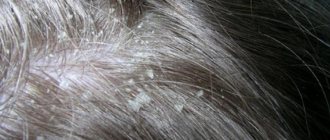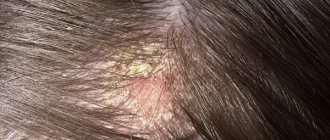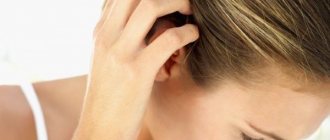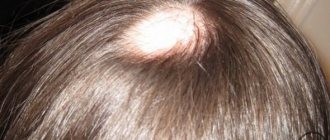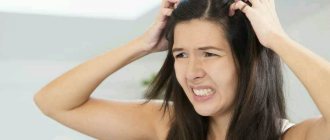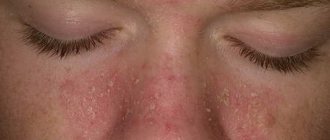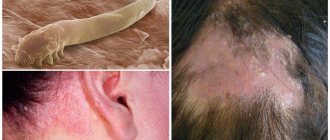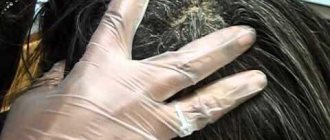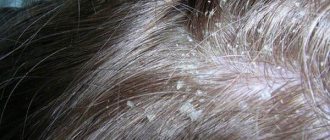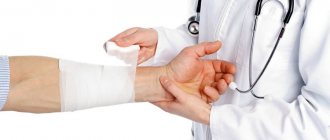Why do they appear
Red spots on the head under the hair are formed due to internal or external factors. If they are caused by the first group of reasons, then we are talking about skin diseases or pathologies in the functioning of organs (in this case, rashes are one of the symptoms). The patient will have to undergo complex treatment.
Spots caused by external factors are considered harmless. They are formed due to exposure to third-party irritants. For example, inappropriate shampoo or hair conditioner. When the unfavorable cause is eliminated, the formations will also disappear.
Endogenous factors
- Diseases of the internal organs lead to redness of the skin. These may be: diabetes mellitus, diseases of the endocrine system, lack of vitamins and microelements, pathologies of the cardiovascular system and gastrointestinal tract.
- Prolonged stay in a state of stress, anxiety, depression also causes the formation of red spots. The patient's hormonal levels change, which affects the condition of the entire body as a whole.
Exogenous causes
- Poor care causes dandruff and red formations on the head. The skin may peel and itch. The most common reasons are unsuitable shampoo or other care product. When a person does not wash their hair well without rinsing off the detergent, it causes redness.
- If red spots appear on the head, this indicates an allergic reaction. Hair dye manufacturers always recommend that you first check whether you are allergic to the dye, and then use it.
Nutritional Features
Trichologists say that the death of some skin cells is normal. When the process is accompanied by the formation of redness at the roots of the hair, severe peeling, you need to sound the alarm.
It is appropriate to associate these manifestations with diseases. On the skin, in the body itself.
For example, a harmful fungus that does not manifest itself for a long time can cause the formation of redness with peeling.
The aggressive effect of some hair wash products on the skin provokes dryness.
Moisturizing masks and creams will help cope with the problem.
Insufficient levels of vitamins and microelements in the body cause redness with severe peeling. Doctors advise taking vitamin and mineral complexes in these situations.
Best Reviewed:
- Vitrum;
- Complivit;
- Alphabet;
- Centrum.
By replenishing the vitamin balance, the problem disappears. These irritations develop as a result of hard water. To avoid the development of flaking, it is better to boil water for washing hair beforehand.
According to the recommendations of nutritionists and trichologists, skin problems arise due to a number of factors:
- The presence of harmful products in the daily menu;
- Poor nutrition as a result of following strict diets;
- Lack of vitamins, microelements;
- Wrong attitude towards nutrition - bulimia or anorexia;
- Lack of proteins important for the whole body.
During periods of exacerbation of skin problems, it is important to exclude salty, canned, and spicy foods. For example, with seborrheic dermatitis or allergic reactions, this rule can play a decisive role. This even applies to onions and garlic. Trichologists do not recommend consuming milk or chicken eggs if redness occurs under the hair.
We suggest you read: Dandruff appears and your head itches: what to do?
You need to eat a varied diet, even during one day. Vitamin deficiency has a bad effect on the skin.
To boost immunity, it is worth taking vitamin and mineral complexes 2 times a year. A doctor - a trichologist or a dermatologist - will help you which one is better to choose based on your characteristics.
Redness should be treated using shampoos based on zinc, selenium sulfide, and ketoconazole. They help cope with various pathogenic bacteria. Salicylic acid has an exfoliating effect and improves the functioning of the sebaceous glands.
Cosmetics based on ichthyol and birch tar restore, renew skin cells, and destroy bacteria. The use of such shampoos, according to reviews, is effective even for such serious skin problems as the rehabilitation period after chemotherapy.
To destroy fungi such as Candida and Malassezia, it is necessary to use the following ointments:
- Zinc pyrithione;
- Ciclopirox;
- Ketoconazole;
- Bifonazole;
- Clotrimazole.
The rating of the most famous shampoos for problematic scalp, based on consumer surveys, looks like this:
- "Nizoral." Reduces discomfort. Itching and flaking are reduced after the first use. It even treats fungus.
- "Dermazol", thanks to the main component ketoconazole, eliminates dandruff. Indicated during the treatment of seborrheic dermatitis.
- "Sebozol" is an excellent remedy in the fight against pathogenic microbes. Indicated for the prevention of seborrhea.
- "Home Institut" is made from plant components of stinging nettle. Restores hair structure, normalizes the activity of the sebaceous glands. Helps with oily seborrhea.
- "Bioderma" relieves itching and flaking. The unique composition of the product eliminates fungus and renews skin cells.
Skin diseases
Dermatological pathologies are considered the most common reason why spots form on the head. It is necessary to seek help from a specialist; the doctor will examine the affected areas and, if necessary, scrapings will be taken. After the results are obtained, the doctor will make a diagnosis and prescribe treatment.
You can see what spots look like in various pathologies in the photo on the Internet. But it is strictly forbidden to diagnose yourself.
Psoriasis
Doctors note that in recent years the number of people with psoriasis has been growing. This is a chronic autoimmune pathology. It cannot be cured, but if the recommendations are followed, people go into remission for a long time. The immune system begins to attack its own dermal cells. As a result, an inflammatory reaction begins.
The main symptom is red, scaly spots on the scalp, arms, elbows, knees, groin, neck and other parts of the body. At first, several spots appear on the dermis, they quickly grow and merge with each other. If the plaques are removed, a silvery film will appear under them, and droplets of blood appear under it. The formations are moist areas of the skin, they itch and flake.
If psoriasis is not treated, plaques cover up to 60% of the entire skin. The pathology goes through four stages; if left untreated, it leads to complications, affects the joints, and causes arthritis.
Seborrhea
This is a common pathology in which the condition of the scalp worsens. It appears due to disruption of the sebaceous glands.
There are three main types of seborrhea:
- dry – the dermis becomes dry as sebum production decreases;
- oily – manifests itself due to increased work of the sebaceous glands;
- mixed form.
With seborrhea, dandruff appears, and in advanced cases, red spots form on the head. Hair becomes brittle and dull; with oily seborrhea, an unhealthy shine is added to the symptoms.
When the disease occurs, the dermis of the face also suffers, acne and blackheads appear on the skin. The pores become enlarged, and the face becomes either oily or unhealthy dry, depending on the type of seborrhea.
Lichen
Most often, red spots on a child's head indicate ringworm. Although the disease also manifests itself in adults. This is the most studied pathology among fungi, caused by two types of fungi: Microsporum or Trichophyton. They affect not only the scalp, but also the nails.
You can become infected with lichen from a sick person or animal. In mammals, the disease is often mild, so identifying a sick animal is not always easy. The child takes the infected kitten in his arms, the parasites get on his skin and soon lichen forms.
Single or multiple red formations appear on the head. The hair above it becomes dull and falls out. Subsequently, the hairs grow, but break off after a few centimeters. It begins to appear that the person has a receding hairline.
Subcutaneous mites
The disease is known as demodicosis. Parasites settle in the upper layers of the epidermis, in the follicles, and feed on dead skin cells.
Main symptoms of the disease:
- red spots appear on the scalp;
- the affected dermis thickens, pustules, pimples or blisters appear on it;
- the skin becomes dry and tight;
- dandruff appears, hair partially falls out as parasites infect the hair follicles.
At the initial stages, the symptoms are subtle, but over time the number of parasites increases and the person begins to experience severe discomfort. Pimples can even appear on the face.
Diagnostics
To make an accurate diagnosis of what caused the spots on the head, it is necessary to carry out a comprehensive diagnosis, which includes:
- Visual inspection by a specialist of the affected areas of the skin.
- Carrying out a study of a broken hair and examining it under a microscope.
- Examination of individual hairs using a Wood's lamp to identify spores or other traces of fungal infection.
- Taking samples of flaky skin for analysis.
- Taking a bacteriological culture , as well as a number of highly informative tests, which are prescribed in case of a positive reaction to the fungus after initial research.
The following symptoms may indicate that the spots on the head are caused by a fungal infection:
- General deterioration in the health of the scalp , which is accompanied by a change in shade, loss of healthy shine, active hair loss and other negative manifestations.
- Peeling of the skin, especially if it is noticed in certain local areas.
- The appearance of bald patches.
- The appearance of pink plaques and other noticeable neoplasms.
- Increased fragility of hairs , especially in the follicle area, which causes such a large number of blackheads on the surface of the head.
- The appearance of purulent foci , this symptom usually appears only in the presence of a superficial form of ringworm.
- The appearance of too much dandruff , especially if there was no such predisposition before.
It must be remembered that all fungal diseases have a very complex internal classification, and they all differ in treatment methods. Therefore, even if you are sure that they were the cause of the spots, self-prescription of therapy is not allowed.
Little ones have spots
Red spots on the head of a baby usually indicate a hemangioma. This is a benign formation that occurs in a newborn in every tenth case. It is associated with disturbances in the functioning of blood vessels (they grow in width).
Hemangioma is a red to dark burgundy spot. It grows actively for up to a year, then growth stops. The size varies, from small formations (up to a centimeter in diameter) to large spots that occupy half the head. The spot does not hurt, does not itch, does not flake off. Convex, turns pale when pressed.
Hemangioma is actively monitored and removed only if there is a threat to health, if it is located next to the mucous membranes.
Scalp treatment at home
At home, you can treat your scalp and hair by following a diet that excludes harmful foods. This is necessary to prevent allergic reactions. The second step would be to use medicated shampoos and limit coloring compounds. To rinse your hair, you can use not just water, but make decoctions or infusions of medicinal herbs, for example, chamomile or nettle. Medicines will help get rid of problems: antifungals, multivitamin complexes, biogenic preparations.
Treatment
- For psoriasis, doctors prescribe topical ointments. Non-hormonal drugs help with mild cases of the disease, hormonal drugs - in advanced cases. Additionally, vitamin complexes, medications that increase immunity, and sedatives are prescribed.
- For seborrhea, select a suitable medicated shampoo (Sulsena, Perhotal, Nizoral). They may prescribe antifungal drugs, vitamins, hormones, and antihistamines. Additionally, it is necessary to adhere to a diet, exclude fatty and salty foods, and maintain a drinking regime.
- Ringworms are caused by fungi. For treatment, you will have to use antifungal drugs, both for local and internal use (in advanced cases). Sometimes vitamin therapy, immunomodulators and drugs to improve skin circulation are prescribed.
- For dermodicosis, doctors recommend products that will destroy mites. Usually this is Metronidazole. It is also necessary to strengthen the immune system (drink vitamins, folic acid).
- If the spots are caused by diseases of the internal organs, then it is necessary to treat the cause itself, and the formations will go away on their own.
Help from folk remedies
Seborrheic dermatitis is characterized by itching and flaking. Seborrhea is episodic.
It can develop on any area of the skin. Dermatitis accompanies allergies or asthma.
Disruption of the sebaceous glands causes oily seborrhea. With dry dandruff, in addition to severe itching, acne appears.
Red spots on the scalp and itching can form due to stress and constant worries. Physical stress, psychological pressure, death of loved ones and other situations provoke excessive production of adrenaline.
As scientists have proven, significant physical activity is required to remove it from the body. If this does not happen, adrenaline, accumulating in the blood, provokes unbearable itching of the skin.
To eliminate the symptoms of seborrhea, it is important to include as many vitamins as possible in your diet. Fruits and vegetables should make up more than half of the total daily diet.
It is important to maintain an adequate distribution of time for work and rest. You need to learn to avoid stress. It is advisable to avoid drinking alcohol, fatty, smoked and salty foods.
In the treatment of folk remedies, herbal medicine occupies the main position. Often the therapeutic effect of masks based on herbal ingredients is irreplaceable.
Here are some recipes:
- Strong tea, vodka and castor oil are mixed in equal proportions, this mask is applied for 30 minutes;
- Apple cider vinegar is rubbed into the skin one hour before washing your hair;
- Full-fat kefir is kept for 30 minutes before washing;
- Natural honey, sour cream, cognac, egg yolk are stirred one tablespoon at a time, leave for 2 hours under a film cover.
Homemade masks help reduce the appearance of seborrheic dermatitis, psoriasis, irritation and other problems.
Some of the easiest to use using natural ingredients:
- Clay, used white or blue, improves the functioning of the sebaceous glands;
- Egg yolks remove excess sebum;
- Essential oils, bergamot, tea tree, lavender, lemon, burdock, castor;
- Sea salt, natural peeling;
- Mustard softens the skin and improves hair structure.
Before using any natural remedies, you should consult a dermatologist. Some components may cause an allergic reaction, and some will not be beneficial.
The herbal composition of masks is healthier than products based on chemical components. Not all of them help cure fungal infections or psoriasis.
What to do first
You can get rid of spots in men and women that appear due to exposure to external factors without consulting a doctor. Many people wonder how to treat red formations at home. The following methods will help:
- In case of allergic reactions, it is necessary to take antihistamines: Suprastin, Zodak, Zovirax.
- If a new shampoo or conditioner is to blame, then you need to apply a mask of burdock oil to your head and wait a few 30-40 minutes, then rinse thoroughly.
- In stressful situations, you should take a sedative.
Preventive measures
There can be many reasons for the appearance of spots on the head, and they are all of a different nature, but compliance with certain preventive measures will minimize the risk of these symptoms.
The range of such events includes:
- Reducing the time spent under the influence of direct sunlight , as well as minimizing the receipt of ultraviolet radiation from any other sources.
- Use only high-quality detergents and cosmetics intended for application to the head, which do not have an aggressive effect, and which have not expired.
- Regular implementation of water procedures and taking other measures to maintain head hygiene.
- Wearing hats during hot or cold periods to provide protection from temperature changes.
- Use only personal combs , hats, towels, hairpins, combs, hair ties and other similar devices.
- Complete refusal or minimization of contacts with people if there is a suspicion that they have fungal or other diseases with similar symptoms.
Brown marks
Sometimes completely unexpected brown spots appear on the skin under the hair. They can be either completely natural or signal some kind of malfunction in the body.
Dark spots
Even under the hair, quite large pigment spots may well be hidden. Most often, such accumulations of melanin are visible from childhood, but they can also occur throughout life, for example, after injuries, burns, illnesses, hormonal changes and taking certain medications.
Most often, age spots do not pose any threat to health. You just need to remember their presence and periodically monitor them for changes in shape, increase or damage. If such situations develop, it is important to consult a dermatologist.
Nevi
Nevi are the same accumulations of melanin, small moles that may well be present on the scalp. Most often they are harmless, but with a protruding round shape they can be potentially dangerous due to the high risk of injury. Owners of moles under their hair should consult a doctor before coloring their hair, as nevi may not react to the chemicals in the best way.
Moles can be dangerous in terms of malignancy.
Melanoma
This is a type of cancer that most often arises from pathologically changed moles. Fortunately, with timely diagnosis, melanoma is highly treatable, so you should definitely consult a doctor if the nevus:
- It grows, changes shape, color and outline.
- Itches, hurts or itches.
- It bleeds, becomes crusty, etc.
Any changes in the condition of moles are a reason for an unscheduled visit to the clinic. It's better to play it safe, but save your life.
Dandruff and sores on the head
Dandruff with sores are detected immediately after a visual examination; at the initial stage of development of the disease, red spots covered with scabs appear, compactions, scales, and small rashes form .
Clinical picture : irritation of the scalp, itching sensations, sometimes purulent discharge and bleeding.
The patient experiences strong discomfort and begins to intensively scratch the affected areas, which leads to the formation of microtraumas and aggravation of the situation. Over time, the condition of the follicles deteriorates and hair may begin to fall out .

